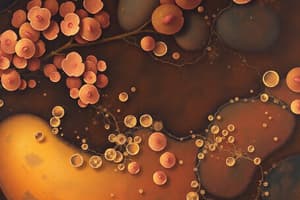Podcast
Questions and Answers
What are the classifications of lipids?
What are the classifications of lipids?
- Simple - Triacylglycerol
- Complex - containing non-lipid components
- Derived - FA, cholesterol
- All of the above (correct)
What does TAG stand for?
What does TAG stand for?
Triacylglycerol
Triacylglycerol is a membrane component.
Triacylglycerol is a membrane component.
False (B)
What is a saturated fatty acid derived from?
What is a saturated fatty acid derived from?
Which of the following statements about unsaturated fatty acids is true?
Which of the following statements about unsaturated fatty acids is true?
What family does linoleic acid belong to?
What family does linoleic acid belong to?
What is the function of arachidonic acid?
What is the function of arachidonic acid?
Which fatty acid is essential for dietary intake from the w-3 family?
Which fatty acid is essential for dietary intake from the w-3 family?
What role does cholesterol play in cell membranes?
What role does cholesterol play in cell membranes?
What are glycerophospholipids primarily composed of?
What are glycerophospholipids primarily composed of?
Fat-free diets can lead to dermatitis.
Fat-free diets can lead to dermatitis.
Which phospholipid is found predominantly on the outer leaflet of the cell membrane?
Which phospholipid is found predominantly on the outer leaflet of the cell membrane?
What is the function of surfactant?
What is the function of surfactant?
Which is a characteristic of glycolipids?
Which is a characteristic of glycolipids?
What do cerebrosides contain?
What do cerebrosides contain?
Study Notes
Classification of Lipids
- Simple lipids include triacylglycerol (TAG).
- Complex lipids contain non-lipid components, while derived lipids include fatty acids and cholesterol.
Triacylglycerol (TAG)
- Composed of three fatty acids ester-linked to glycerol.
- Predominantly found in butter, serves as energy storage in adipose tissue.
- Hydrophobic in nature and not a component of cellular membranes.
Saturated Fatty Acids
- Found in both simple and complex lipids, characterized by being hydrophobic and unbranched.
- Higher chain length correlates with increased myelin content.
- Examples include palmitic acid (16 carbon) and stearic acid (18 carbon), which decrease membrane fluidity.
Unsaturated Fatty Acids
- Derived from both simple and complex lipids and include one or more double bonds.
- More double bonds result in increased fluidity; examples include olive oil and polyunsaturated fatty acids (PUFAs).
Linoleic Acid
- A polyunsaturated fatty acid (PUFA) from the omega-6 family, designated as 18:2 and considered essential in the diet.
- Acts as a precursor to arachidonic acid and enhances membrane fluidity.
Arachidonic Acid
- Another PUFA from the omega-6 family, labeled as 20:4.
- Precursor to prostaglandins, which play roles in inflammation and membrane fluidity enhancement.
Alpha-Linoleic Acid
- A PUFA from the omega-3 family, designated as 18:3 and essential in the diet.
- Serves as a precursor to eicosapentaenoic acid (EPA) and contributes to increased membrane fluidity.
Eicosapentaenoic Acid (EPA)
- A PUFA from the omega-3 family, labeled as 20:5, recognized for cardiovascular benefits.
- Precursor to docosahexaenoic acid (DHA) and promotes membrane fluidity.
Docosahexaenoic Acid (DHA)
- A PUFA from the omega-3 family, designated as 22:6, crucial for myelination and vision.
- Enhances membrane fluidity.
Essential Fatty Acids
- Humans cannot synthesize linoleic acid (omega-6) and alpha-linoleic acid (omega-3).
Effects of Fat-Free Diets
- Can lead to dermatitis and hair loss.
Trans Fatty Acids
- Behave similarly to saturated fatty acids, resulting in low mobility within membranes.
Cholesterol
- An amphipathic lipid derived from both simple and complex lipids, possessing an -OH group and steroid ring structure.
- Plays a crucial role in regulating membrane fluidity and serves as a precursor to bile acids, hormones, and Vitamin D.
Complex Lipids
- Composed of non-lipid components.
- Include phospholipids (glycerolphospholipids, sphingophospholipids) and glycolipids (cerebrosides, sulfatides, globosides, gangliosides).
- Main functions involve forming cell membranes and exhibiting amphipathic properties.
Glycerophospholipids
- Composed of a glycerol backbone, saturated and unsaturated fatty acids, and phosphate.
- Includes various types such as phosphatidyl choline (most abundant), phosphatidyl serine (indicator of apoptosis if on the outer leaflet), phosphatidylethanolamine, and phosphatidylinositol (source of second messengers).
Surfactant
- Secreted by type II alveolar cells, it reduces surface tension in the lungs (DPPC).
- Critical in preventing atelectasis, with increased risk factors for chronic smokers and preterm infants.
Sphingophospholipids
- A type of phospholipid consisting of sphingosine, fatty acids, phosphate, and choline.
- Found predominantly in the myelin sheath and the outer leaflet of plasma membranes.
Glycolipids
- Amphipathic lipids classified as complex lipids, located primarily in the outer leaflet of cell membranes.
- Functions include serving as receptors and contributing to the glycocalyx, which facilitates cell recognition and interaction.
Cerebroside
- A type of glycolipid containing glucose or galactose.
- Located in the outer leaflet of membranes and contributes to the formation of the glycocalyx.
Studying That Suits You
Use AI to generate personalized quizzes and flashcards to suit your learning preferences.
Description
Explore the essential components of lipids through flashcards that cover classifications like simple, complex, and derived lipids. Each card provides definitions and characteristics of key lipid types, including triacylglycerols and saturated fatty acids. Perfect for students looking to enhance their understanding of lipid biochemistry.




